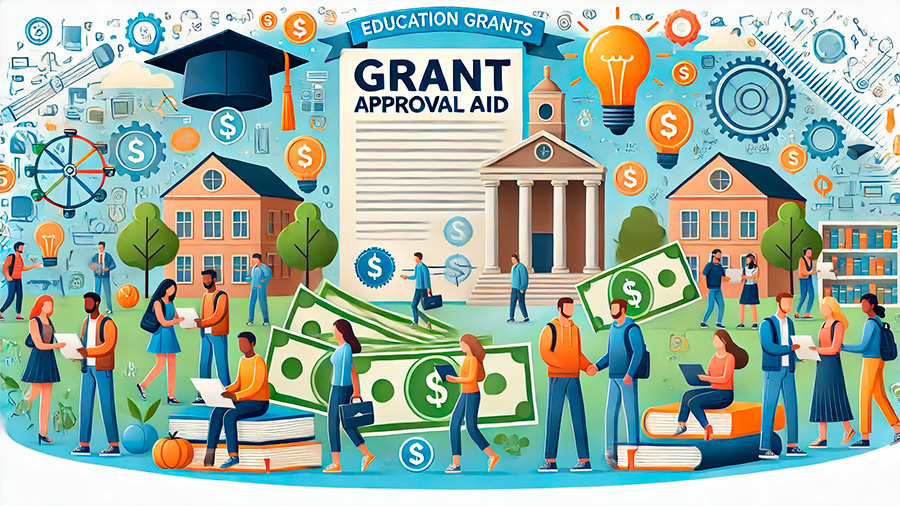Higher education can be one of the most significant investments in your future. However, for many students, the rising cost of tuition and related expenses can create a barrier to achieving their academic goals. Education grants offer a valuable solution to this problem, providing funding that does not require repayment. These financial aids are designed to help students from all backgrounds pursue their educational aspirations without the burden of student debt. This article explores how education grants work, where to find them, and how they can offer a debt-free path to success.
What Are Education Grants?
Education grants are a form of financial aid provided by governments, institutions, and private organizations to help students pay for their education. Unlike loans, grants do not require repayment, making them a highly sought-after option for students who need financial assistance. Education grants are typically awarded based on factors such as financial need, academic merit, or specific criteria like career goals or area of study.
1. Types of Education Grants
There are several types of education grants available, each with its own eligibility requirements and application processes. While government-funded grants are the most common, there are also numerous private grants offered by institutions, foundations, and organizations.
Common types of education grants include:
- Federal Grants: The U.S. government offers a variety of grants, the most well-known being the Pell Grant, which helps low-income undergraduate students. Other federal grants include the Federal Supplemental Educational Opportunity Grant (FSEOG) and Teacher Education Assistance for College and Higher Education (TEACH) grants.
- State Grants: Many states provide financial assistance to residents attending in-state institutions. State grants may be merit-based, need-based, or specific to certain fields of study.
- Institutional Grants: Colleges and universities may offer grants to students who attend their institution. These grants are often need-based or awarded to students based on academic performance or extracurricular achievements.
- Private Grants: Many foundations, corporations, and nonprofit organizations offer grants to students pursuing specific fields of study or career paths, such as healthcare, engineering, or the arts.
2. How Education Grants Differ from Loans
While both grants and loans are forms of financial aid, there are important differences between them. The most significant difference is that grants do not require repayment, while loans do. This makes grants a highly attractive option for students who wish to avoid the financial burden of loan repayment after graduation.
Key differences between grants and loans:
- No repayment for grants: Unlike loans, grants do not require repayment, allowing students to focus on their education rather than future financial obligations.
- Loan obligations: Loans must be repaid with interest, often over many years, which can create a long-term financial burden for graduates.
- Eligibility requirements: Grants are typically awarded based on need or merit, while loans may be offered to a broader range of students based on creditworthiness or co-signers.

How to Qualify for Education Grants
Qualifying for education grants requires meeting specific eligibility criteria set by the granting body. This may include factors such as financial need, academic achievement, residency status, and enrollment in an eligible educational program. The process of applying for grants can vary depending on the type of grant, but there are a few common steps that students can follow to increase their chances of receiving funding.
1. Complete the FAFSA
The Free Application for Federal Student Aid (FAFSA) is a crucial first step for students applying for federal and state grants. The FAFSA collects financial information to determine the student’s eligibility for financial aid, including grants, work-study, and loans. Many state and institutional grants also require the FAFSA as part of their application process.
Steps to complete the FAFSA:
- Gather required documents: Prepare your financial documents, such as tax returns and proof of income, before starting the FAFSA.
- Submit the FAFSA: Complete the FAFSA online at the official government website, ensuring all information is accurate and up to date.
- Meet deadlines: Be aware of application deadlines for federal, state, and institutional grants to ensure that you are considered for the maximum amount of financial aid.
2. Research State and Institutional Grants
In addition to federal grants, many states offer financial aid to residents attending in-state colleges and universities. These grants may be based on need, merit, or specific career goals. Colleges and universities often provide their own grants to help students pay for tuition and fees. Researching available state and institutional grants is crucial to ensuring you don’t miss any funding opportunities.
How to apply for state and institutional grants:
- Check state websites: Visit your state’s education department website to find out about available state grants and eligibility requirements.
- Contact your school’s financial aid office: The financial aid office at your college or university can provide information on available institutional grants and scholarships.
- Understand the criteria: Be sure to carefully review the eligibility requirements, as some state and institutional grants may require specific GPA thresholds or enrollment in certain academic programs.
3. Apply for Private Grants
In addition to federal, state, and institutional grants, numerous private organizations, foundations, and corporations offer grants to students. These grants may be for students pursuing specific fields of study, students with unique backgrounds, or those involved in certain community or extracurricular activities.
How to apply for private grants:
- Search for grant opportunities: Use online databases, such as Fastweb or Scholarships.com, to find private grants for which you might be eligible.
- Review eligibility: Private grants may have specific requirements, such as academic performance, field of study, or geographic location.
- Prepare your application: Many private grants require essays, letters of recommendation, and transcripts, so make sure to gather all necessary materials before applying.

The Advantages of Education Grants
Education grants offer several key benefits to students, making them a highly attractive option for funding college education. Unlike loans, grants do not add to a student’s financial burden after graduation, making them an ideal form of financial aid.
1. Debt-Free College Education
The most significant advantage of education grants is that they do not need to be repaid. This allows students to pursue their studies without the worry of future loan payments, which can otherwise be a long-term financial burden. By reducing or eliminating the need for loans, grants help students avoid accumulating debt during their college years.
2. Financial Security and Peace of Mind
Education grants provide financial relief that enables students to focus on their academic work rather than worrying about how to cover tuition or living expenses. With the cost of education rising, grants offer an essential way to reduce the financial strain on students and their families.
3. Expanding Access to Higher Education
Grants are especially important for students from low-income backgrounds, as they help level the playing field and make higher education more accessible. By removing financial barriers, grants allow more students to pursue their educational goals and enhance their career opportunities, regardless of their financial situation.
Conclusion
Education grants are a powerful tool in making higher education accessible to all students, regardless of their financial background. By providing funding that does not need to be repaid, grants reduce the financial burden of attending college, allowing students to focus on their studies and future careers. With a variety of grants available from federal, state, institutional, and private sources, students have many opportunities to secure the financial aid they need to achieve their academic goals. By completing the FAFSA, researching available grants, and applying for opportunities, students can take the first step toward a debt-free education and a brighter future.




